The AMD Ryzen Threadripper 1950X and 1920X Review: CPUs on Steroids
by Ian Cutress on August 10, 2017 9:00 AM ESTRocket League
Hilariously simple pick-up-and-play games are great fun. I'm a massive fan of the Katamari franchise for that reason — passing start on a controller and rolling around, picking up things to get bigger, is extremely simple. Until we get a PC version of Katamari that I can benchmark, we'll focus on Rocket League.
Rocket League combines the elements of pick-up-and-play, allowing users to jump into a game with other people (or bots) to play football with cars with zero rules. The title is built on Unreal Engine 3, which is somewhat old at this point, but it allows users to run the game on super-low-end systems while still taxing the big ones. Since the release in 2015, it has sold over 5 million copies and seems to be a fixture at LANs and game shows. Users who train get very serious, playing in teams and leagues with very few settings to configure, and everyone is on the same level. Rocket League is quickly becoming one of the favored titles for e-sports tournaments, especially when e-sports contests can be viewed directly from the game interface.
Based on these factors, plus the fact that it is an extremely fun title to load and play, we set out to find the best way to benchmark it. Unfortunately for the most part automatic benchmark modes for games are few and far between. Partly because of this, but also on the basis that it is built on the Unreal 3 engine, Rocket League does not have a benchmark mode. In this case, we have to develop a consistent run and record the frame rate.
Read our initial analysis on our Rocket League benchmark on low-end graphics here.
With Rocket League, there is no benchmark mode, so we have to perform a series of automated actions, similar to a racing game having a fixed number of laps. We take the following approach: Using Fraps to record the time taken to show each frame (and the overall frame rates), we use an automation tool to set up a consistent 4v4 bot match on easy, with the system applying a series of inputs throughout the run, such as switching camera angles and driving around.
It turns out that this method is nicely indicative of a real bot match, driving up walls, boosting and even putting in the odd assist, save and/or goal, as weird as that sounds for an automated set of commands. To maintain consistency, the commands we apply are not random but time-fixed, and we also keep the map the same (Aquadome, known to be a tough map for GPUs due to water/transparency) and the car customization constant. We start recording just after a match starts, and record for 4 minutes of game time (think 5 laps of a DIRT: Rally benchmark), with average frame rates, 99th percentile and frame times all provided.
The graphics settings for Rocket League come in four broad, generic settings: Low, Medium, High and High FXAA. There are advanced settings in place for shadows and details; however, for these tests, we keep to the generic settings. For both 1920x1080 and 4K resolutions, we test at the High preset with an unlimited frame cap.
All of our benchmark results can also be found in our benchmark engine, Bench.
MSI GTX 1080 Gaming 8G Performance
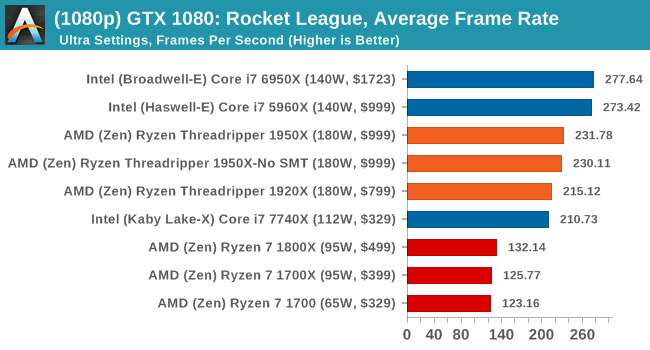
1080p

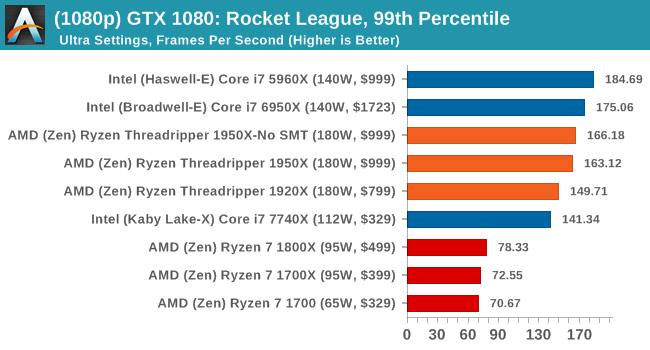
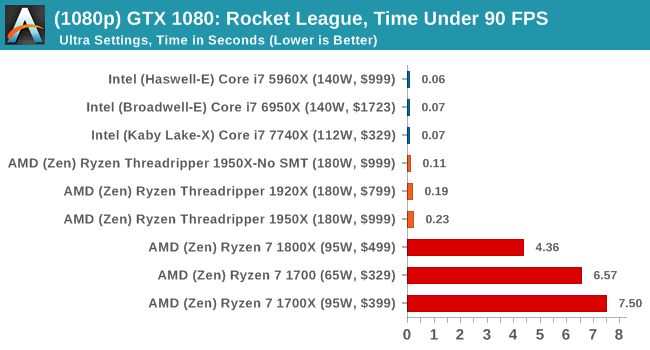
4K

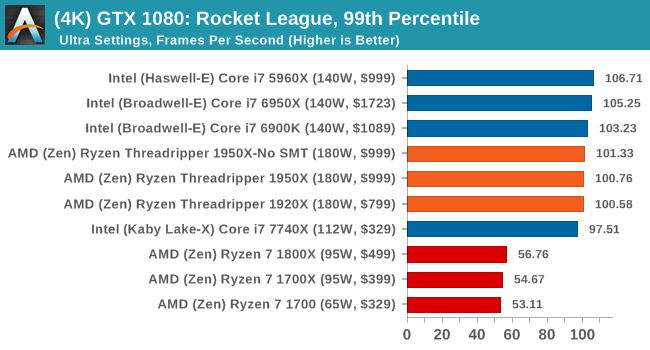
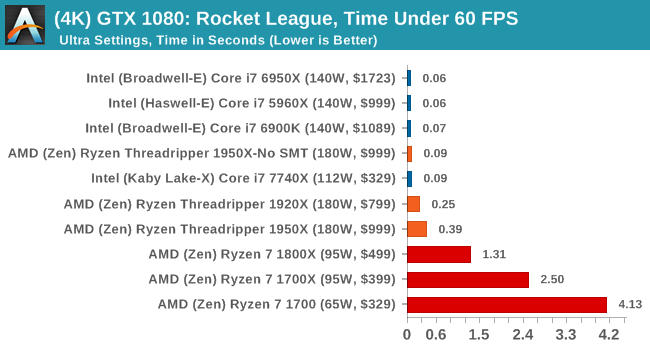
ASUS GTX 1060 Strix 6G Performance
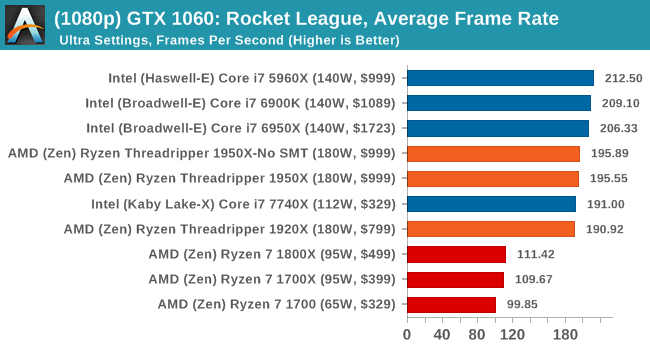
1080p

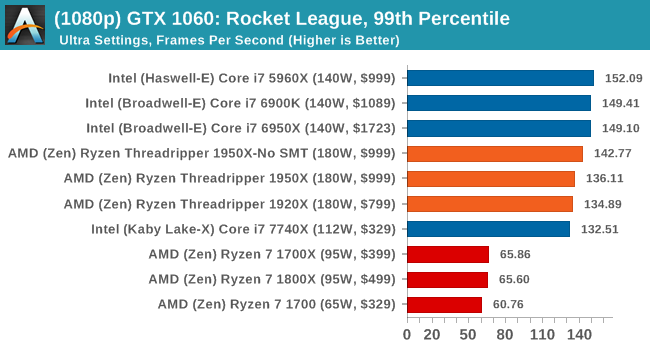
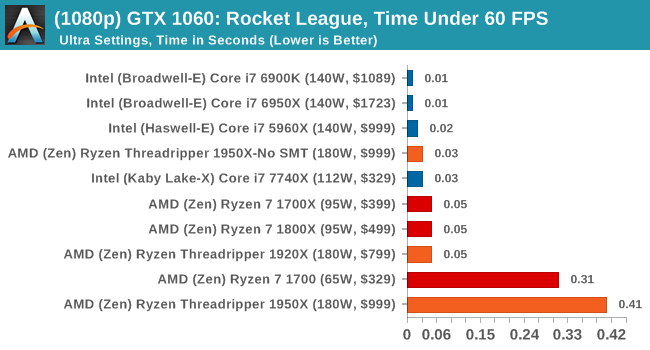
4K
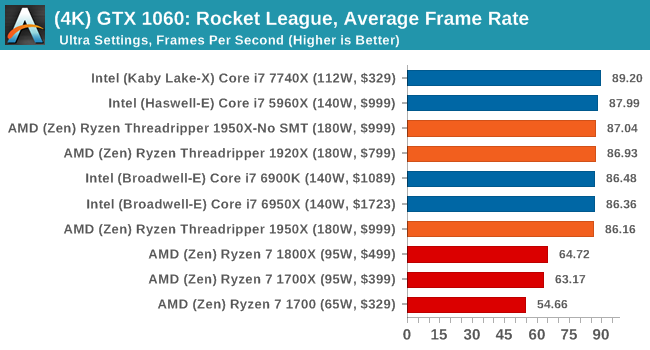
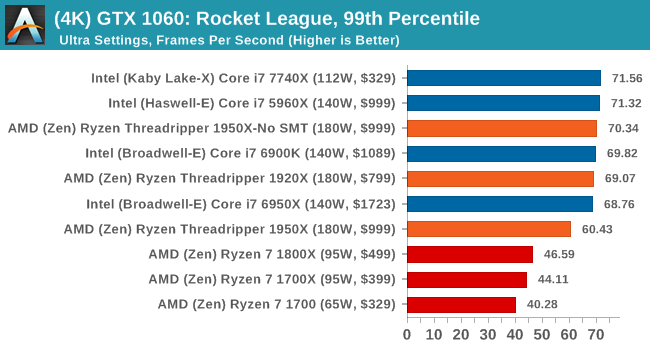
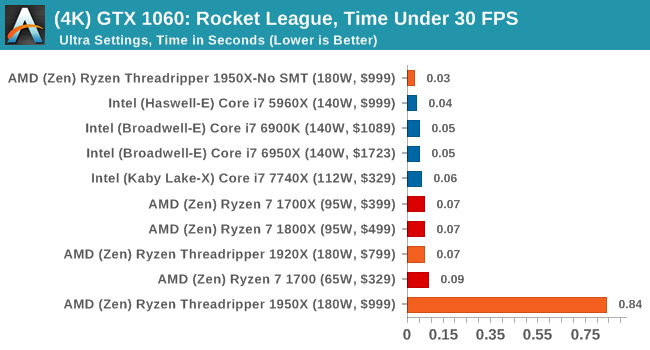
Sapphire Nitro R9 Fury 4G Performance
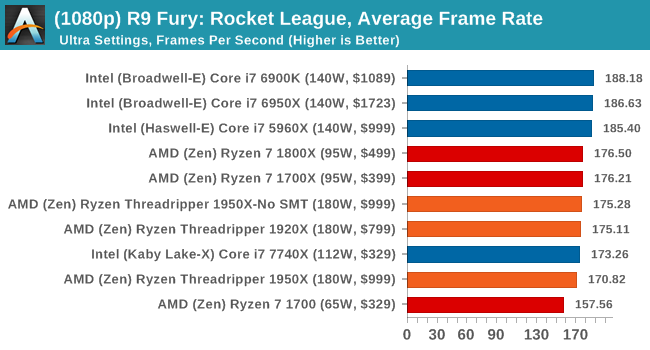
1080p

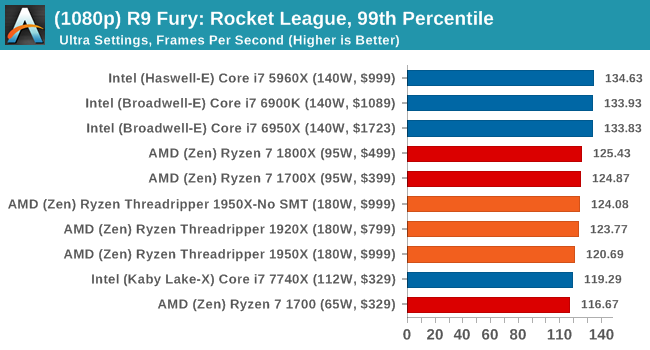
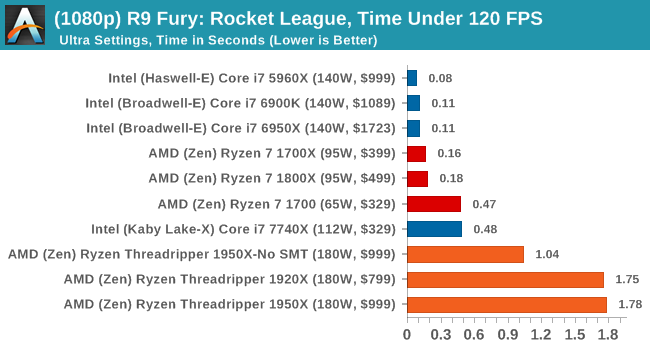
4K
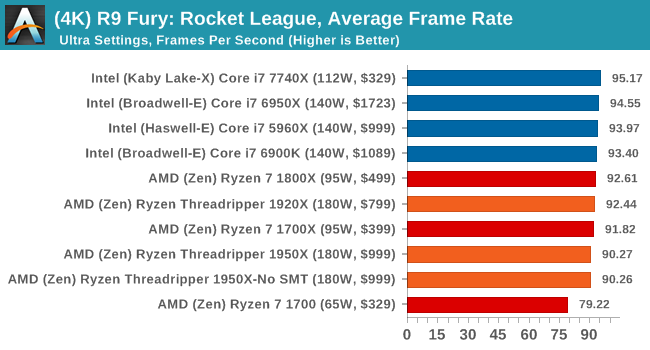
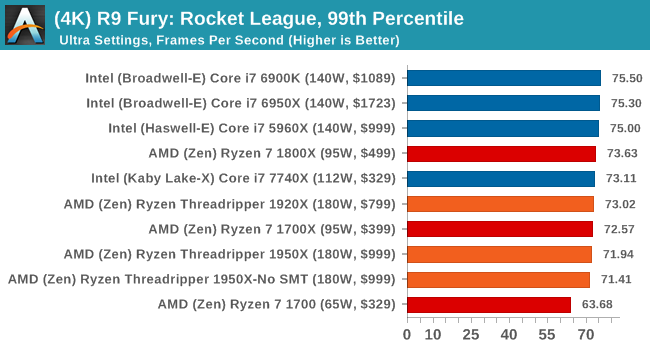

Sapphire Nitro RX 480 8G Performance
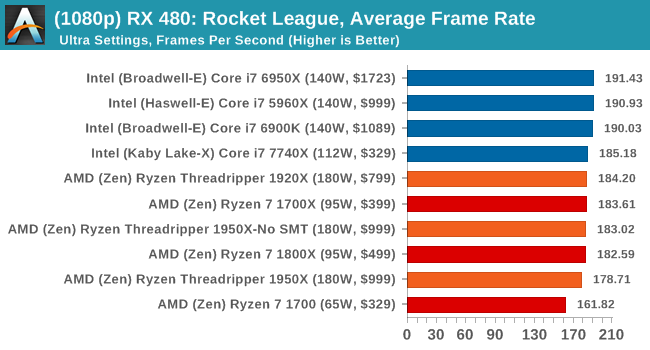
1080p

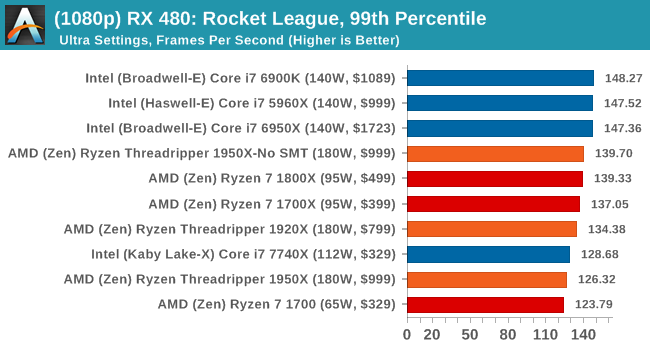
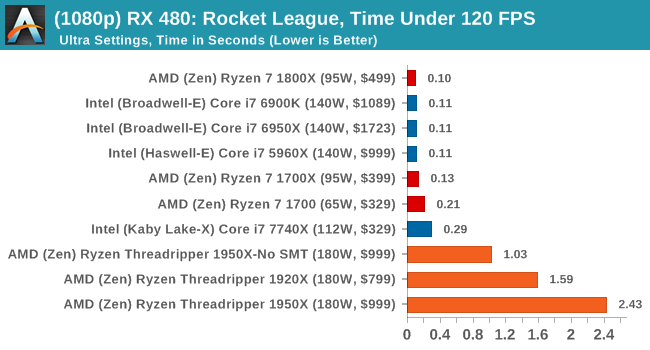
4K
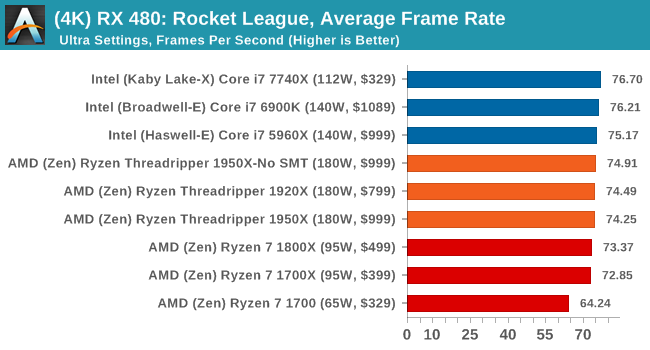
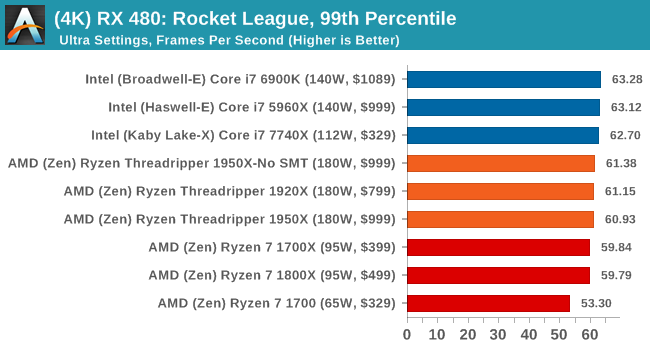
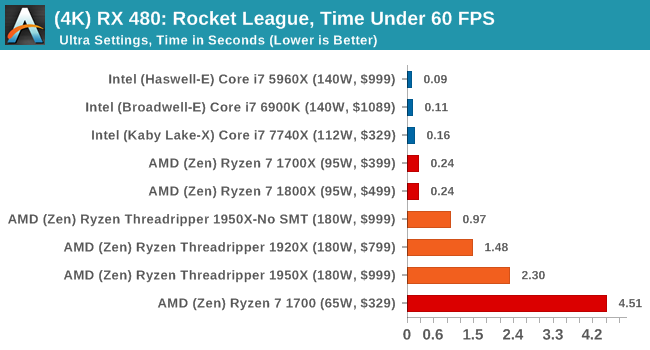
With Ryzen, we encounted some odd performance issues when using NVIDIA-based video cards that caused those cards to significantly underperform. However equally strangely, the issues we have with Ryzen on Rocket League with NVIDIA GPUs seem to almost vanish when using Threadripper. Again, still no easy wins here as Intel seems to take Rocket League in its stride, but SMT-off mode still helps the 1950X. The Time Under graphs give some cause for concern, with the 1950X consistently being at the bottom of that graph.


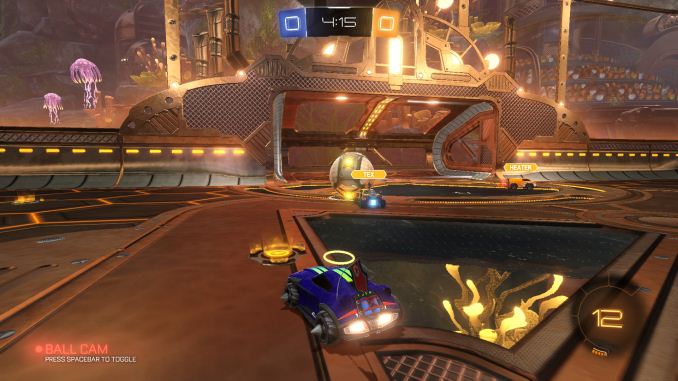
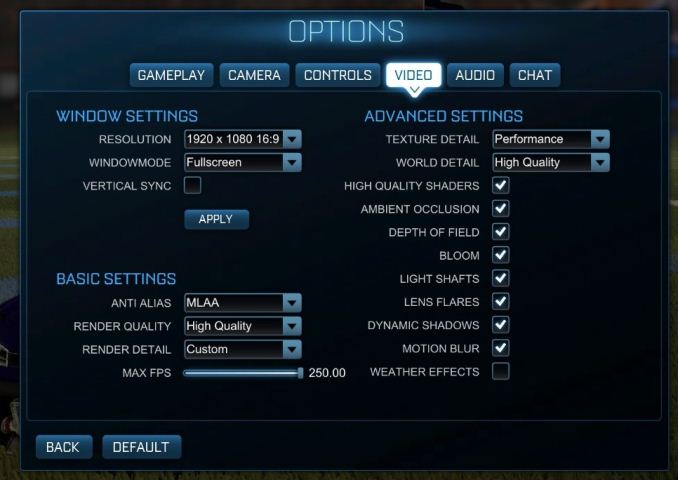








347 Comments
View All Comments
drajitshnew - Thursday, August 10, 2017 - link
You have written that "This socket is identical (but not interchangeable) to the SP3 socket used for EPYC,".Please, clarify.
I was under the impression that if you drop an epyc in a threadripper board, it would disable 4 memory channels & 64 PCIe lanes as those will simply not be wired up.
Deshi! - Friday, August 11, 2017 - link
No AMD have stated that won;t work. Its probably not hardware incompatible, but they probably put microcode on the CPUS so that if it doesn;t detect its a Ryzen CPU it doesn't work. There might also be differences in how the cores are wired up on the fabric since its 2 cores instead of 4. Remember, Threadripper has only 2 Physical Dies that are active. on Epyc all processors are 4 dies with cores on each die disabled right down to the 8 core part. (2 enabled on each physical die)Deshi! - Friday, August 11, 2017 - link
Wish there was an edit function..... but to add to that, If you pop in an Epyc processor, it might go looking for those extra lanes and memory busses that don;t exist on Threadripper boards, hence cause it not to function.pinellaspete - Thursday, August 10, 2017 - link
This is the second article where you've tried to start an acronym called SHED (Super High End Desktop) in referring to AMD Threadripper systems. You also say that Intel systems are HEDT (High End Desktop) when in all reality both AMD and Intel are HEDT. It is just that Intel has been keeping the core count low on consumer systems for so long you think that anything over a 10 core system is unusual.AMD is actually producing a HEDT CPU for $1000 and not inflating the price of a HEDT CPU and bleeding their customers like Intel was doing with the i7-6950X CPU for $1750. HEDT CPUs should cost about $1000 and performance should increase with every generation for the same price, not relentlessly jacking the price as Intel has done.
HEDT should be increasing in performance every generation and you prove yourself to be Intel biased when something finally comes along that beats Intel's butt. Just because it beats Intel you want to put it into a different category so it doesn't look like Intel fares as bad. If we start a new category of computers called SHED what comes next in a few years? SDHED? Super Duper High End Desktop?
Deshi! - Friday, August 11, 2017 - link
theres a good reason for that. Intel is not just inflating the cost because they want to. It literally cost them much more to produce their chips because of the monolithic die aproach vs AMDs Modular aproach. AMDs yeilds are much better than INtels in the higher core counts. Intel will not be able to match AMDs prices and still make significant profit unless they also adopt the same approach.fanofanand - Tuesday, August 15, 2017 - link
"HEDT CPUs should cost about $1000 "That's not how free markets work. Companies will price any given product at their maximum profit. If they can sell 10 @ $2000 or 100 at $1000 and it costs them $500 to produce, they would make $15,000 selling 10 and $50,000 selling 100 of them. Intel isn't filled with idiots, they priced their chips at whatever they thought would bring the maximum profits. The best way for the consumer to protest prices that we believe are higher than the "right" price is to not buy them. The companies will be forced to reduce their prices to find the market equilibrium. Stop complaining about Intel's gouging, vote with your wallet and buy AMD. Or don't, it's up to you.
Stiggy930 - Thursday, August 10, 2017 - link
Honestly, the review is somewhat disappointing. For a pro-sumer product, there is no MySQL/PostgreSQL benchmark. No compilation test under Linux environment. Really?name99 - Friday, August 11, 2017 - link
"In an ideal world, all software would be NUMA-aware, eliminating any concerns over the matter."Why? This is an idiotic statement, like saying that in an ideal world all software would be aware of cache topology. In an actual ideal world, the OS would handle page or task migration between NUMA nodes transparently enough that almost no app would even notice NUMA, and even in an non-ideal world, how much does it actually matter?
Given the way the tech world tends to work ("OMG, by using DRAM that's overclocked by 300MHz you can increase your Cinebench score by .5% !!! This is the most important fact in the history of the universe!!!") my suspicion, until proven otherwise, is that the amount of software for which this actually matters is pretty much negligible and it's not worth worrying about.
cheshirster - Friday, August 11, 2017 - link
Anandtechs power and compiling tests are completely out of other rewiewers results.Still hiding poor Skylake-X gaming results.
Most of the tests are completely out of that 16-core CPU target workloads.
2400 memory used for tests.
Absolutely zero perf/watt and price/perf analisys.
Intel bias is over the roof here.
Looks like I'm done with Anandtech.
Hurr Durr - Friday, August 11, 2017 - link
Here`s your pity comment.